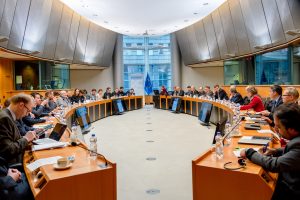
Valenciaport locates the “decarbonization” and the digitization of its activities as priority axes of port management
Ramón Gómez-Ferrer has spoken at the “Fit for the Future” conference.
• The plan, coordinated by the Valenciaport Foundation and supported by the Valencian Agency of Innovation and the PAV, has allowed the detection of 44 areas of innovation.
Valencia, January 28th , 2019.- The subdirector of strategic planning of the Port Authority of Valencia (PAV), Ramón Gómez-Ferrer, spoke at the European Parliament in the framework of the conference “Fit for the future and Development for the European Waterbon”, organized by the SEARICA parliamentary intergroup and the Waterbone Technology Platform. The objective of this event was to present the contents of the Strategic Research Agenda and discuss with policy-makers and other stakeholders about the needs and importance of the Waterbone community with respect to research and development.
Gómez-Ferrer, who has been the only representative of a port to participate in this conference, has presented a paper on “Decarbonization, digitalization and logistics – around 2050”, in which he has shared the Innovation Plan of Valenciaport developed by the Foundation Valenciaport in collaboration with the PAV and the Valencian innovation agency (VIA).
Specifically, Gómez-Ferrer explained that this plan has been based on the analysis of I+D+I developed by the main European ports and other leading global operators and has allowed analyzing the contribution of the key players of the Valencian port cluster in matters such as environment, energy, and safety; digitalization and automation; and new logistic business models. Based on this analysis, 44 innovation trends have been identified grouped into 7 categories of the logistic-port chain: port infrastructures, terminals, port operations, maritime transport, ships, land transport and logistics.
Among the main innovations detected in this plan are, in terms of environmental sustainability: the evolution towards a zero emissions model thanks to the use of renewable energies and the electrification and use of alternative fuels such as LNG or hydrogen; the monitoring of the carbon footprint, or environmental bonuses, among others. Regarding the area of digitalization and automation, according to Gómez-Ferrer, the innovation plan has made it possible to detect actions to predict and manage land access, plan and optimize maritime operations, automation of terminals and vehicles or traceability services in blockchain networks. Finally, in the area of new logistics models, the plan opens the door to the promotion of innovation through start-ups or the development of new circular economy logistic models.
Gómez-Ferrer has also taken advantage of his intervention in the European Parliament to explain that, at present, the role of ports goes beyond being a mere node in the global transport network, but they are facilitators of the economy and development commercial of its interior. It has also indicated that ports are facing an environment that changes very rapidly due, fundamentally, to three factors: a clear commitment to sustainability and reducing the environmental impact of ports; the implementation of new technological advances such as digitization, automation or the blockchain; and a change in the traditional business models of the ports, which allows creating new opportunities thanks to the increase in efficiency and the collaborative economy.
Waterbone
Waterbone was created as a technological platform oriented to the maritime industry to establish a continuous dialogue between all stakeholders in the water, such as classification societies, energy companies, infrastructure companies, environmental non-profit organizations, manufacturers, institutes of research, shipyards, port operators and ports, universities, fishermen associations and citizens, as well as European institutions and Member States.

